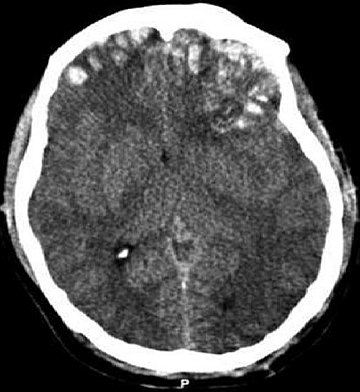Did you know?
You can double click on a word to look it up on TermGallery.
You can double click on a word to look it up on TermGallery.
Meanings of intracranial injury in English
Russian
черепно-мозговые травмы Portuguese
tce Spanish
embolia encefalocraneal Catalan
traumatisme cranioencefàlic 
Condition caused by an external force which has traumatically injured the brain.
Synonyms
Examples for "tbi"
Examples for "tbi"
1
Conclusion: Evidence for WM impairments following TBI is consistent with previous research.
2
Mounting evidence shows facial affect recognition to be particularly difficult after TBI.
3
Conclusions: More severe TBI was associated with a diminished risk of PTSD.
4
Subjects provided TBI history information at baseline and one annual follow-up visit.
5
A lot of people with TBI have trouble finding or remembering words.
1
Background: Propofol is commonly used to sedate patients after traumatic brain injury.
2
Participants: 77 patients admitted for their first rehabilitation after traumatic brain injury.
3
The critical care management of patients with traumatic brain injury is complex.
4
Such variability is elevated in neurodegenerative diseases or following traumatic brain injury.
5
Background: Optimal glycaemic targets for patients with severe traumatic brain injury remain unclear.
1
Methods: A 29-year-old man presented with head injury following road traffic accident.
2
Results: The medical records of 629 children with head injury were examined.
3
You could have a closed- head injury and we don't know the severity.
4
Kelly said St. Brown was being evaluated for a possible head injury.
5
The patient suffered head injury and extensive burns following a car accident.
Usage of intracranial injury in English
1
Conclusions: Our data are consistent with current biomechanical concepts of intracranial injury.
2
There was no evidence of intracranial injury in the 35H group.
3
Patients: Twelve children with intracranial injury secondary to child abuse.
4
Scalp swelling, in particular, has been associated with intracranial injury.
5
Children younger than 2 years appear to have a higher risk of intracranial injury following minor head trauma.
6
These results suggest that COx may be an acceptable substitute for Mx monitoring in patients with acute intracranial injury.
7
Twenty-three of these 180 patients underwent neuroimaging, and seven had an intracranial injury (including one ischemic stroke).
8
Rarely, diabetes insipidus can manifest as a new entity months later in patients who have previously had an intracranial injury or operation.
9
ICD-10-based ICISS had some disadvantages in predicting outcomes among patients with intracranial injuries.
10
Initially missed intracranial injuries were rare, and none needed neurosurgery or intensive care.
11
For patients with intracranial injuries, the predictive power of ICD-10-based ICISS was relatively low because of differences in the classifying system between ICD-10 and ICD-9CM.
This collocation consists of:
Translations for intracranial injury
Spanish

